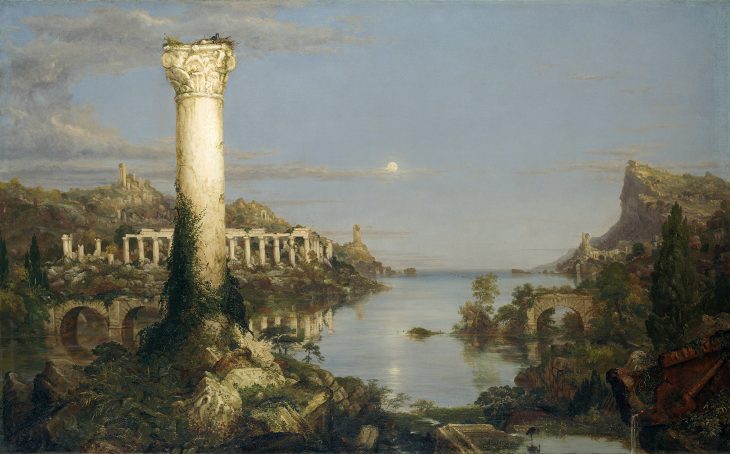For Americans, Thomas Cole is a household name. He painted America’s wild landscapes and lamented its destruction by the country’s early industrialisation. Yet the Lancaster-born Cole is little known in Britain, living stateside for most of his adult life. The National Gallery has been working with the Met to bring home Cole and his works. And what a homecoming it is.
Inspired by Turner and Constable, Cole was a self-made man, learning to paint through tenacity and a small collection of books. Like Constable, Cole obsessed over nature and ideas of decay (Constable’s crumbling ‘Hadleigh Castle’ was a favourite). From Turner and Claude, Cole learned for the first time that skyscapes can be depicted in glorious oranges and the deepest blues, simultaneously fantastical and realistic.
Not that Cole needed any help in imagining the ethereal. One of his early works was ‘The Garden of Eden’, in which a verdant foreground of tropical woods framed a luminescent mountain waterfall in the distance, calling to mind God’s Olympian seat.
Through these allegorical scenes, Cole produced a political manifesto. The centrepiece for which is ‘The Course of Empire’ – a sublime, fantastical series of five paintings, each showing a time of day and a state in human civilisation. From the morning light of the ‘Savage State’, where a lone hunter chases a deer, to the golden age in ‘Consummation of Empire’, where a white marble metropolis buzzes with crowds. Luxurious pleasure barges sit beneath a richly decorated bridge. The scene is maximalist in its colours, stories, noises. That bridge collapses with the weight of invaders in the afternoon light of the next episode. And in the evening of ‘Desolation’, the finale of the series, only ruins of the great city remain, as wild vegetation race up to cover the last traces of civilisation. Two herons nest in the city, the only sentient life in sight.
The opulent golds and pinks of the Empire sowed the seeds for the fiery hell of destruction; in the end, nature will reclaim the land. Humans should stay in Arcadia, somewhere between the pure state of nature and the height of opulence. Cole’s message is clear if a little heavy-handed – the destruction and industrialisation of the countryside is wrong.
Yet in fact, ‘Desolation’ is the most beautiful of the five. The single Corinthian column stands pale against the evening sky, cracked and half eaten by vines. The city is drowned, some ruins peeking above water. Beyond the horizon, the evening sun barely lights up the scene. In the painting, the sky is much bluer than you will see online. The composition of the piece – the light upon the pillar, the serene sky, the quiet of a ruined civilisation – instils a sense of hope. Instead of reading ‘The Course of Empire’ as a cautionary tale where one static snapshot of human development is the privileged one, the series is also a life cycle. If nature can reclaim, then we are back to step one, and empires can rise again.
By the time of his early death at the age of 47, Cole’s popularity had established the Hudson River School of art, so named after his masterpiece, ‘The Oxbow’. The work depicted the Hudson river dividing two states in human progress, and reiterated the point of ‘Course of Empire’. To the right, ploughed land, felled forests, smoke rising; to the left, dark green moss cover haggard trees, cushioned by messy shrubbery. Above, an ominous sky lifted straight from Turner’s ‘Snow Storm’ (a moody depiction of Hannibal crossing the Alps), dominates the wild side but is pushed back grudgingly by the brightness of civilisation.
But what Cole did not predict were the perks that would come with industrialisation – more wealth than has ever been seen before, longer life spans, new ways of life. The tension between the man-made and the God-made was reconciled by Cole’s Hudson River School disciples. His friend and student Asher Durand makes a direct reference to ‘The Oxbow’ in his ‘Progress’ (1853), also in the exhibition. The canvas is again divided between the man-made and the natural. But this time, golden rays fall over the entire vista, the picture showing a harmonious whole. In the end, the consummation of empire doesn’t have to lead to destruction and desolation.







Comments